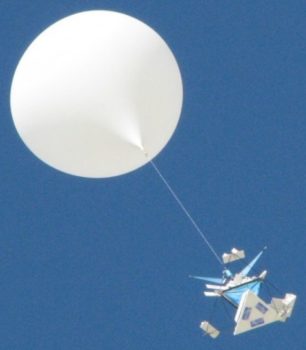
Most would consider this an odd question and probably ignore it or just delete it. Not so fast, please, my friends!
The answer to the question is important in understanding the puzzling ineffectiveness of the greenhouse gas (GHG) carbon dioxide (CO2) in warming the climate — as seen in the 20th-century record and as deduced from the existence of the widening gap between the model results based on rising CO2 and observations of atmospheric temperatures by both satellites and radiosondes [Fig. 1]
Fig. 1 –Model results vs. observations[i]
Note the growing “gap.”
“Greenhouse gas” only means that CO2 absorbs some infrared (IR) radiation; it does not guarantee climate warming.
In fact, the outcome depends mostly on atmospheric structure, measured by balloon-borne radiosondes. It is expressed by the so-called atmospheric lapse rate (ALR), defined as the change in atmospheric temperature with altitude.[ii][Note that “lapse rate” has nothing to do with back-sliding alcoholics and smokers.]
Physicists who have examined our counter-intuitive hypothesis, all agree with the science — albeit somewhat reluctantly. Such is the power of groupthink that even experts, with some exception, find the idea that CO2 might cool the climate difficult to accept.
The ALR is generally negative in the troposphere[iii] as much as [minus] -6.5 degrees C per km of altitude. [The troposphere is the lowest atmospheric layer, from zero up to about 50,000-foot altitude.]
ALR goes through zero in the tropopause region, the layer that separates the troposphere from the overlying stratosphere. The ALR turns positive in the stratosphere, just above [see schematic nearby.[iv] [The warming of the stratosphere is produced by absorption of energy by stratospheric ozone.]
|
STRATOSPHERE |
ALR is positive |
Temperature increases with altitude |
|
TROPOPAUSE |
ALR is zero |
Temperature is constant |
|
TROPOSPHERE |
ALR is negative |
Temperature decreases with altitude |
Fig. 2 Schematic of the lower atmosphere
The key result
Adding a tiny increment of CO2 raises slightly the “effective” altitude for emitting Outgoing Long-wave (OLR), the Radiation (IR), going out to space from a CO2 molecule.
Because of the reversal in the atmospheric temperature structure, OLR is:
- of lower energy than normal if the effective altitude remains in the troposphere; and
-
a bit higher than normal if this effective altitude is in the stratosphere.
In case 2., the stratospheric CO2 emission “borrows” some energy from the surface emission — hence “cooling” the surface.
Assumptions
It is incumbent upon the proponent of a controversial hypothesis to find potential weak points — and to list crucial assumptions. To be sure, critics will soon enough find many more.
- It seems safe to assume that CO2 molecules, excited and de-excited by collisions with more abundant nitrogen and oxygen molecules, emit at the temperature of the surrounding atmosphere.[v]
- We may also assume that CO2 is well mixed with altitude, as inter-hemispheric mixing is nearly perfect.
- But — can we assume that energy balance is nearly perfect, even on very short timescales? — i.e. will OLR always exactly equal absorbed solar short-wave radiation? I think the answer is yes. The times involved are too short to permit energy to go into or come out of ice or ocean.
- Most important, are CO2 transitions strong enough to penetrate past the tropopause into the stratosphere? We can see evidence for this in the year-by-year increase of the amplitudes [near the center of the 15-micron CO2 absorption band. This increase comes about because the stratospheric ALR is positive. To verify and extend this observation, we may use data from the AIRS satellite instrument. (AIRS is a satellite-borne IR spectrometer with ultra-high resolution in wavelength.)
Once confirmed, the hypothesis can furnish an additional explanation for the observed absence of CO2 warming in the 20th century,[vi] and perhaps also for the cause of the puzzling observed warming pause (‘hiatus’)[vii] of at least the past two decades [Fig 1].
A typical reaction
“That’s a very nice theory. And, I think I can follow your argument. But, where is the predicted cooling?”
One can think of three possible answers:
- First, the warming and cooling effects are very small; remember that the CO2 effect becomes logarithmicx, once CO2 concentration exceeds roughly 60 ppm (parts per million). [The concentration is now 400 ppm, 0.04%, and growing].
- Any cooling would be offset, at least partly, by molecular transitions that remain in the troposphere and cause climate warming in a conventional way.
- Finally, there is climate noise that would hide any small warming or cooling. Climate noise is produced both naturally and by human sources. For example, changes in the weather may change global cloudiness and therefore incoming absorbed solar energy.
Conclusion
A greenhouse gas produces cooling of the climate when its molecular transitions are in a region of the positive lapse rate.
One example is CO2 and the stratosphere, where temperature increases with altitude. Another example is temperature over the winter poles [Happer – private communication; Flanner et al. GRL 2018].
While the climate cooling is not obvious, it counters [conventional] GH warming.
This at least partial cancelation might explain the puzzling absence of CO2-based GH warming in the 20th century.[viii] It could also help explain the cause of the [hotly] contested climate ‘pause.’[ix]
Much further work awaits!
Read rest at American Thinker

















Now global cooling that is scary . But when did EXXON know ?
Must have missed Dr. Singer’s article in the NYT ‘s .
The global cooling scare could be used to get all those people to move back to California .
If Mexico is free to dump it’s citizens into the USA in an unharmed invasion why doesn’t the USA just start taking Mexico territory in exchange . No wall necessary . Over 10% of California’s population are illegal ‘s . If 4 million people show up with guns what would be the response ? Why should illegals by pass all those that follow the laws of the land ?
These “greenhouse gases” are more properly called “radiative gases.” In sunlight, these gases are saturated with IR and converting IR to heat and heat to IR, having no detectable effect.
But, at night, which is not part of any of the climate models, these gases unilaterally convert heat to IR which is them lost to space. This is why the air cools down so rapidly after sunset and why breezes pick up so quickly in the shadows of scudding clouds on a partly sunny day.
If anything, these gases serve to cool the planet.
Water Vapor,
The only PROVEN ghg,
definitely and without question
Cools the planet.